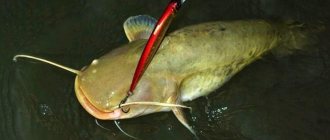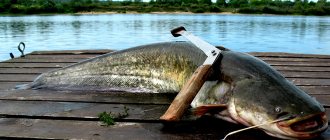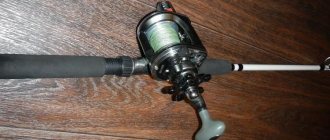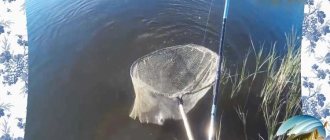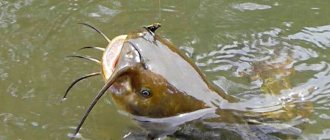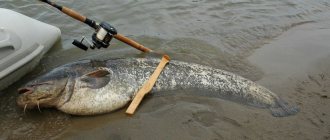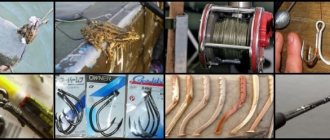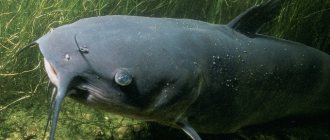Catching catfish using kwok. How it all started
Several years ago we had a catfish boom on the Volga and Kama. Catching catfish using kwok has become very popular. The gear sold out in local stores with a bang. People bought expensive echo sounders specifically for this fish. Handmade quacks were ordered weeks in advance. Everybody caught catfish, or rather tried to catch it. As it turned out, finding his camp site turned out to be much easier than forcing this predator to take bait. Fishermen saw it in the echo sounder, but could not catch it.
The whole beauty of catfish fishing with an echo sounder lies in its entertainment. You clearly see the fish on the device screen and try to force it to bite. If it weren’t for the echo sounder, we could have gone to another point a long time ago. But the alluring screen with a real picture makes you try again and again to slip the bait under the nose of the predator. Here he rises from the bottom, now he approaches the bait, which is also visible on the echo sounder, but does not take it. Eh, what a shame.
And you again work as a kwok, calling this predator to you. If luck smiles and there is contact, then you give a few seconds so that the catfish swallows the bait well and sharply hooks it. The muscles are tense, adrenaline rushes into the blood. You feel someone struggling at the other end of the tackle. You experience an unforgettable feeling when catching catfish with a kwok.
How to set up an echo sounder for catching catfish using a kwok
An echo sounder for catching catfish with a kwok does not have to be expensive. Of course, the expensive one is better, but to see the bait and fish, the simplest model is enough. I use a regular black and white single-beam echo sounder like this one from Aliexpress (link will open in a new window). But no matter which model you use, their settings will be approximately the same, since we mainly work with two parameters: “sensitivity” and “depth range”.
The first thing we need to do is remove the function that displays fish as symbols (fish icons) and set the display mode to arcs. Then you need to adjust the depth correctly. The echo sounder has a “depth range” parameter. For example, from 0 to 5 meters, from 5 to 10 meters and so on. So, you need to adjust the closest depth value at the fishing spot.
If you fish at 12 meters, then set it to 15 or 20 meters, depending on how the scale in your echo sounder is divided. If we stand at 8 meters, then we set it to 10 meters. This is necessary so that the echo sounder operates at the minimum signal emission power for a given depth and scares off fish less with radiation.
Living creatures sense impulses emanating from the echo sounder sensor. Therefore, the lower the power of these signals, the better.
Next we will work with the “sensitivity” parameter. If you set it too much, then all the interference will be visible: any bubbles and pieces of algae in the water. If you set it too low, the bait will not be visible. Therefore, we lower our bait a meter from the bottom and set the sensitivity so that the bait is reflected on the device screen. It will appear as a solid line on the screen. All is ready. Now let's talk about bait and how to get it.
How to catch a crawler for catching catfish using a quok
Catfish are omnivores, so they are caught on a wide variety of baits. Among them: locusts, chafer larvae, mole crickets, scorched carcasses of sparrows, frogs, bird liver, squid, crayfish necks, barley shells, fish fry (live bait). In different regions, catfish are caught with different baits. In the Kuibyshev Reservoir and on the Kama, the most common bait for catfish is the crawler.
Unlike an ordinary earthworm, they do not dig it, but hunt it. This method is quite exciting and somewhat reminiscent of fishing. Let me tell you in more detail how I get this bait.
The crawl is a huge worm more than 20 centimeters in length. He's fat and juicy. Just what a hungry catfish needs. The crawlers emerge to the surface under the cover of darkness and onto moist soil. The rest of the time they sit in their burrows deep underground. Therefore, you need to wait for rain, or water the soil in the garden abundantly before the upcoming hunt.
As soon as it gets dark, the crawlies will begin to crawl out and stretch out along the ground. But catching them is not so easy. The worm's tail is always in the hole and as soon as the crawling gets scared, it disappears into its house in a split second. Therefore, we take a very weak flashlight with a dim light, so as not to scare away the coward and the construction glove. We walk through the garden and look for bait. Did you see the crawl? Now we slowly bring our hand up and grab his head.
If the crawler was in a hole, then it will stay in it with its lower body. How it is held there and what prevents it from getting out, I cannot judge, but do not rush to take it out - it will tear. Just hold it there for 5-10 seconds and it will loosen the muscles.
Then the crawl can be safely pulled out and the hunt can continue. Thus, in an hour you can easily collect up to a hundred fat worms.
How to make a kwok quickly
How to make a quok with your own hands for catching catfish, simply and quickly. I'll tell you now.
It is not known for certain why the catfish reacts to sounds produced with the help of a quok. There are many opinions on this matter on the Internet, but I am not inclined to any particular point of view. It’s enough for me to know that it works, and let scientists figure out why. Our task is to catch catfish with a quok.
A good kwok from a renowned master is not cheap. In fact, it is the same instrument in the hands of a fisherman, like any musical instrument in a musician. The catch depends on the correct quok and its skillful use. But my experiments showed that a kwok can be made from scrap materials for pennies and it will also work.
This is evidenced by 4 different quokkas that I made literally on my knees and all of them brought me more than one catfish. The largest catfish in my life was 15 kilograms, but mostly these are 7-9 kilogram specimens. But it’s also quite difficult to fish them out alone, sitting in a small inflatable boat. So, all my quotes turned out to be working and are easy to do.
Kwok from a coin
I didn’t spend too much time fiddling with the precise angles at which the snout should be located relative to the body, or as it’s called the Kwoka knife. My task was to do it quickly, try the kwok in work, and then experiment. I took an old ruble coin from the USSR era. I drilled a longitudinal hole in it and cleaned it with a file. Then I cut out a kwok knife from an old piece of duralumin. He inserted a coin and riveted it. I cleaned the base with sandpaper.
To prevent the quok from sinking, the handle was made from ordinary insulation. This is extruded polystyrene foam - a durable foam that is used to insulate houses. It can be easily processed with a knife. I wrapped the handle with electrical tape. It took me less than an hour to make the first quok. Using the same principle, I made several more, but with a different shape of the snouts to make different sounds on the water. Let's experiment. There is nothing difficult to make, but learning how to extract the correct buns will be more difficult.
In fairness, it must be said that I had the opportunity to work with expensive quokkas from craftsmen, made of titanium and noble wood species. They all worked, but my regular aluminum fishing rods also brought me catches. For myself, I concluded that it is not the quok that catches catfish, but the ability to use it. Even if it’s just an ordinary soup spoon, it can also make sounds.
Kwok for catching catfish with your own hands: drawings, video of proper production
Kwok is a very effective tool for hunting catfish, which has come to us from ancient times in almost unchanged form. Today, other materials are used to make the kwoka, but the device itself and the principle of operation remain the same as they were.
Despite the fact that there are various versions of quok fish on sale, most fish catchers prefer to make their own beaters for catching catfish. And this is explained primarily not by the desire to save money, but by the fact that it is with hand-made quoks that you can achieve the best results in catching baleen. Let's figure out how to make kwok for catfish with your own hands.
Kwok consists of three main parts :
Each of these parts must be manufactured so that it can best perform its function.
The handle should be comfortable, therefore, it should be made of a pleasant-to-touch material that will not slip in the hand . In addition, if the kwok is not made of wood, the handle should be made of light material to ensure its buoyancy - after all, when biting a trophy, the firecracker can easily be dropped from your hands, and it will be very disappointing to lose a catchy kwok made with your own hands.
The knife , located between the handle and the coin, should not interfere with the formation of bubbles during quoting, the rupture of which causes gurgling sounds attractive to catfish. The thinner it is, the better , in this case it will be as easy as possible for the fisherman to croak, producing the sound of the desired boominess and sonority.
The purpose of the snout is to capture a little air with each blow of the quok on the water and drag the resulting bubble under the surface. It should have as sharp edges as possible , while the patch can be either concave or flat.
- Kwok Atanova;
- Kyiv Kwok;
- Severodonetsk;
- Hungarian.
The Atanovsky quok is the easiest to manufacture version of a mallet for hunting catfish. That kwok has a straight knife that can be cut from steel, duralumin or other metal, a rectangular-shaped metal head with rounded corners and a wooden handle.
The Kiev Kwok differs from the Atanovsky one only in the curved shape of the knife , which smoothly turns into a handle. It is more difficult to make such a kwok with your own hands, and more material will be required to make it.
Severodonetsk Kwok is very similar to the Kiev one, but differs in a steeper curve of the knife and the shape of the penny , which in this model, unlike the previous two, has an oval shape.
The Hungarian quok is perhaps the most bizarre of all the flapper options for catching catfish. It has the shape of a sickle ; the knife, which smoothly transitions into the handle, has two smooth bends.
Stories from our readers. Theme: fishing suit
Georgy V. Kaliningrad – “For me, fishing is half of my life. For as long as I can remember – from the age of 5 with my father until now, I have always been fishing. And if finding a good spinning rod is not a problem now, then with fishing suits it’s a real hemorrhoid. I probably tried about 10 of them. Including the popular fishing slide version. There is nothing truly good. It's cold, it's hot. There are few pockets, but the seams are torn. Half a year ago I ordered another one, a special fishing one. And lo and behold! I didn't expect such good quality. I don’t have any problems anymore - the fabric is excellent, it doesn’t get wet, even in rain, even in hail, even in terrible frost. 11 pockets! I recommend it to everyone! Check out the link below, you'll love it!”
The main materials for making a patch are:
A knife can be made from:
To make a handle you can take:
There are many ways to increase your fish catch, but the most effective ones are. Below, the site editors share with you the 3 most effective ways to increase your catch:
- Bite activator. This is a pheromone-based additive that activates receptors in fish. ATTENTION! Rybnadzor wants to ban this bait!
- Any other baits with flavorings are less effective; it is better if they contain pheromones. But the most effective way is to use the new product of 2016 - DYNAMITE EFFECT!
- Learning different fishing techniques. For example, it is written here about spinning wires.
Even though many quack makers prefer to use wooden quoks, the best today, perhaps, are the quoks, the knife and snout of which are made of metal .
Metal kwok has a number of important advantages :
- ease of use : as noted above, in order to obtain the sonorous “gurgle” necessary to attract catfish, it is best to use quacks with thin knives and snouts with a sharp edge; for this reason, quacks with metal crackers are noticeably easier than with wooden ones;
- ease of manufacture : in order to make a metal quok, you just need to cut out a knife of the desired shape, attach a handle and a snout to it, while with the same wooden quoks everything can be much more complicated;
- durability : well-made metal quok is reliable and durable, it can be considered almost eternal.
The disadvantages of metal include:
- sound less natural and pleasant than that of a wooden quok;
- negative buoyancy.
Speaking about wooden quoks, it can be noted that they are very beautiful, especially if they are carved from a single piece of wood.
However, they are not durable and less convenient to use than metal clappers; it is more difficult to get the desired sound with them, and the angler gets tired faster when fishing with a wooden clapper. Quokas carved from a single piece of wood are very labor-intensive to manufacture .
Since Atanova’s quok is easier than others to make and at the same time no less catchy (as many experienced fishermen say), it is well suited for the first quok made at home .
So, where to start and how to make a kwok correctly?
First of all, we need to prepare materials :
- a sheet of metal 2-2.5 mm thick for making a knife (duralumin works well);
- metal 3-5 mm thick for a penny (you can use aluminum for this purpose);
- wooden slats 20 mm thick and 30 mm wide (for example, oak).
HOW TO CHOOSE A SUIT FOR FISHING?
- The main thing is the fabric and lining. To be warm in winter and not hot in summer. It would be great if it were polyester fabric with a through-cell structure that wicks away moisture and allows the skin to breathe.
- presence of pockets. The more and the better they are located, the better.
- Straps and hood are required. It would be great if the bottom is treated with a drawstring with a cord and clamps
Very few suits have such properties. Even the popular “slide” option for fishing is not what you need. So far, the only option on the Russian market is suits from this online store. This is the quality standard. All requirements above have been met. Look - especially now there is a promotion: 50% discount on your first purchase and a flashlight as a gift!
How to work with a kwok
On the Internet you can watch many videos on how to work with kwok correctly. Here is one of such videos. The video will open directly in the article
It's hard to describe this process in words, you have to try it. Your task is to grab the air bubble with the heel of the quok and drag it under water. When the bubble comes to the surface, it will collapse and make a sound. For some it happens faster, for others it takes longer. It took me about an hour to get the correct sound on 8 out of 10 beats. I trained in the bay from an inflatable boat and in a large barrel in the garden.
Some anglers believe that it is better to catch catfish from an inflatable boat, since the iron hull scares away this predator. But I have many friends who successfully hatch catfish from aluminum Kazankas. So, those who catch do not believe in these moments regarding the fact that catfish are repelled by metal. The main thing here is to catch, and when you don’t catch there are always many reasons.
Selection, making quok
A quok is a special device consisting of a handle, a cutwater and a hoof.
To make kwok, they try to use “light”, floating materials. It can be wood, bone, or even bread crumbs, well dried in the sun. In online stores you can find a large selection of quoks made of wood, metal, and plastic. They may differ slightly in shape from each other. If you decide to buy a kwok in a store, then it is important to be able to choose it correctly. It is advisable to pay attention to the following:
- The handle of the quok should be comfortable and light. It is better if it is wooden. Be sure to hold the tackle in your hands before purchasing.
- Next, look at the material from which the cutwater is made. It must be metal. It is necessary that the cutwater be thin, easily enter the water, without splashing.
- And finally, the hoof. Most often it is made of metal. Although you can also find plastic, wooden, or cast from epoxy resin options. The main thing is that the hoof is perfectly smooth. Do not make indentations in the middle. It won't improve the sound.
When choosing and making a quok, it is important to observe correctly all the angles of inclination of the hoof and cutwater. Remember - the angle between the handle and the cutwater should be 60 degrees.
The kwok is a classic tool for catching large catfish. Its task is to attract fish to the bait. To do this, fishermen hit the surface of the water with a quok, which is why the corresponding sound occurs. Let us repeat, it is still unknown why exactly this sound is attractive to catfish. Some say that the sounds coming out remind the fish of the sounds that the female makes, others say that these sounds resemble the sounds that the prey makes.
Experienced fishermen make kwok on their own, adjusting it to suit themselves. The handle is made of maple or apple wood, given the usual shape, sanded, and varnished.
To make a water cutter, take a duralumin plate and clamp it in a vice at an angle of 60 degrees.
Make a shape for the hoof from plasticine. Pour the hoof itself out of epoxy resin. Make two holes at the end of the cutwater to better connect the two materials. The water cut should be deepened into the hoof by about 5 mm. After the resin has hardened, process everything with a file and sandpaper.
Schemes of the structure of quoks of different sizes
Video tutorial on all the physical principles of the quok design
The intricacies of quok making, choosing a quok and the nature of the sounds made by a quok are described in a detailed video tutorial by Pavel Bekhter.
Cutting edge for catching catfish
Catching catfish with a kwok is not only a kwok. If you plan to constantly engage in catfish fishing, then over time you will need to purchase a special power rod, a powerful reel and braided cord. These tackles will make the fishing process much easier. But first, you can collect the edge. This is the simplest tackle that is used not only by beginners, but also by experienced fishermen. There are even fishermen who would never trade a cutting edge for a fancy fishing rod. To each his own. The edge does not take up much space and is quite reliable.
What is a cut?
So, what is tackle? The edge is a wooden reel on which a rope-cord with a diameter of 2-4 mm is wound. Such cords can be purchased at fishing and construction stores. 30 meters will be enough. Next you need a swivel that can withstand heavy loads. In my photo it’s 40 kg to break. The leash can be a thick line up to 1 mm, or a twist of several thin lines.
But, in my opinion, the best option is soft, durable braid. Of course, a braided cord can quickly be rubbed by catfish teeth, which are like fine iron bristles. But with small catfish I had no problems in this regard. But the braid is soft and the fish do not feel it when testing the bait. The leash itself is about 1.5 meters long.
A heavy lead weight hangs above the leash. You can buy it or cast it yourself. The weight of the load is selected relative to the current. The load must be under the boat within the range of visibility of the echo sounder sensor and not being carried away by the draft. The weight is put on a rope through a through hole and fixed. Some fishermen wrap the load with electrical tape. It is believed that this way the catfish feels the metal less and approaches the bait more boldly. I can’t say for sure whether this is true. I have edges both with closed loads and with open ones and there was a bite on each one.
Sometimes such cargo is hidden in the body of a large silicone squid, which is used in sea fishing. This decoy serves to attract a curious catfish. A large spot of straightened tentacles can be seen in the water from afar, and already underneath it hangs an appetizing bait.
Catching catfish with kwok requires sharp and strong hooks. I use Japanese ones. They are expensive, but it is justified in catfish fishing. On the same Aliexpress, it is now not a problem to buy catfish hooks (link will open in a new window). You can fish with a single hook, with a double hook, or with a tee like the one in the photo. It is very convenient to put on a bunch of crawlers and other soft bait.
Kwok design
If you decide to make a quok yourself, know that its design includes the following parts:
- Pen;
- Knife;
- Piglet.
Each part has its own function and therefore, if you decide to make a quok yourself, then these parts will have to meet certain criteria:
- The handle should be adjusted to you so that it is comfortable for you to hold it. Make it from a material that will allow you to hold it well in your hand, even if it is wet, so that it does not slip out of your hands. As a rule, it is made of wood.
- The knife should be thin enough so as not to cause strong water resistance. As a rule, it is most often made of steel, aluminum or wood.
- The patch is best made of metal. Try to make its surface as smooth as possible, this will significantly improve the sound quality.
How to make a drawing
The drawing is not so difficult to draw; even someone who is completely unfamiliar with this device can do it. When making a drawing, pay attention to the following points:
- Decide what shape you want your instrument to have;
- The second aspect is the width of the handle. As a rule, about 30 mm, but you can make it narrower or wider, as is more convenient for you;
- A Kwoka knife is usually made with a bend; the length of the handle before the bend should be about 12 cm;
- Its length should not be more than 22 cm;
- Make sure that there is an angle between the handle and the cutwater (knife) in the range of 35-40 degrees;
- The knife should gradually taper from handle to tip from 25 mm to 20 mm;
- The heel width is also about 25 mm.
Select form
If you want to make a catfish quok with your own hands, it is worth considering the options for its design, the main 4:
- Atanovsky Kwok. Due to the simplicity of its manufacture, it is the most common. His knife is straight, the kind that can easily be made from metal, and the penny has a rectangular shape with rounded edges. The handle is usually made of wood.
- Kyiv Kwok. The difference between it and the previous one is that its knife has a curved shape, which has no corners, but smoothly transitions into the handle. It is worth noting that it will be much more difficult for you to make such a quok, and you will also need more raw materials.
- The Severodonetsk kwok is generally similar to the Kyiv one, but its knife is more steeply curved. It also features a striker that is oval in shape.
- Hungarian Kwok. It looks very fancy and resembles a sickle in shape. The blade smoothly transitions into the handle and has 2 smooth bends.
Water anchor or parachute for catching catfish
This important attribute is very helpful, especially in windy weather. A water anchor is needed to slow down the boat during rafting. The speed of a boat with a parachute drops considerably. By tying the anchor to different places on the boat, you can set a comfortable position for the vessel in which it is comfortable to nod.
When you float slowly, you can carefully fish a promising place and conveniently monitor the bait on the echo sounder screen. There are many options on the Internet on how to make such a parachute. I took the simplest route and did the following. I made a semblance of a quadrangular pyramid from large bags, with a hole at the base. There is an iron rod through the bottom and it sinks. There is a wooden stick at the top, and an empty plastic bottle is tied above it, which acts as a float.
When it gets into water, the structure straightens out as in the photo. It turns out to be an underwater parachute. It is attached to the boat at a distance of several meters and slows down the rafting speed. If you plan to constantly catch catfish, then you need a water anchor. This is what it looks like in the factory version (link will open in a new window)
Making a kwok with your own hands
For the first case, a sample of the Atanovsky kwok is suitable, since it is the easiest to manufacture. The most important thing is that the kwok works properly.
First of all, you should do the preparatory work, depending on the material of manufacture:
- If the kwok is made of metal, then you will need a sheet of metal 2-2.5 mm thick to make a knife. The most suitable material is duralumin.
- The nickel is also made from the same material as a knife, but with a thickness of 3 to 5 mm.
- A piece of wood, section 20x30 mm. It doesn’t really matter what kind of wood it is, but it’s better if it’s a durable tree, like oak.
After this, you can proceed directly to its manufacture:
- First of all, the knife is made. To do this, a blank is cut out of a sheet of metal, up to 30 cm long and 2.5 cm wide at the top and 2 cm at the bottom. You can cut a blank from duralumin using metal scissors or another available method.
- 22 cm are measured from the bottom edge of the knife, after which the workpiece is clamped in a vice and the end (bottom) is sharpened.
- At the next stage, the workpiece is cultivated, removing burrs and sharp corners. This can be done with a file, and then the workpiece is sanded using sandpaper.
- After this, they begin to make the handle. For this, a wooden blank with dimensions of 150x35x25 mm is prepared. Taking a protractor in your hands, mark an angle of 35-40 degrees. It is at this angle that the handle should be attached to the knife.
- To secure the knife, a cut should be made in the handle. All joints must be smoothed. The handle should fit snugly and comfortably in your hand.
- A joint is formed at the bottom of the knife, in the form of a short finger.
- The next stage is devoted to the production of a nickel, which is characterized by dimensions such as 45x25 mm. You will have to drill a hole in the center of the nickel so that the finger of the lower part of the knife fits into it. At the same time, on the outside of the nickle it is necessary to form a secret recess using a thicker drill. In this case, the connection between the coin and the knife will be the most durable.
- Using a file, you need to round the edges of the nickel and give it an ellipsoidal shape.
- After precise adjustment of all parts, they are connected into a single structure called kwok. The wooden handle is attached to the product using epoxy glue, and the coin with the knife is attached using rivets. At the same time, you need to rivet carefully and efficiently so that the nickel is not skewed. In addition, after stripping, there should be no shells at the joints so that they do not affect the nature of the sound produced.
Where to look for catfish when fishing with kwok
Catching catfish with a quok is also possible on small rivers with depths of 5-7 meters, but I fish on such large rivers as the Volga and Kama. If you have an echo sounder, identifying a promising place is not so difficult. Usually these are deep channel holes. Catfish can also rest right under a steep bank, where there are deep waters. Now catfish are already accustomed to water transport and are not afraid of the noise of propellers from motor ships and barges. I often caught catfish several tens of meters from the shipping channel. A ship passes, and after some time a bite follows.
That is, on an unfamiliar body of water we look for a hole and float over it, working with a kwok. If there is a catfish, it will definitely show itself on the echo sounder screen. Moreover, this is usually visible already in the first minutes of the beginning of nodding. If you wait an hour and there is no fish in sight, then there is a high probability that there is simply no fish in this hole.
I managed to catch catfish on a flat bottom with depths of up to 7-8 meters. But rather these were exceptions. Larger numbers of this barbel were always caught over the pits. My friends managed to hook large catfish weighing from 25 to 35 kg on a jig head when fishing for pike perch using a spinning rod. Moreover, the depths where these specimens were caught were less than 4 meters. But you need to understand that at such depths it is not possible to catch catfish using a kwok from a boat. It just won't fit.
Fishing technique
Catfish should be caught by two people on a drifting boat or a dinghy under sail.
Place fishing rods in the bow and along the sides. Cover the tip of the hook with the nozzle. Lower the bait to a depth of 5–7 m. As bait you can use: a singed bird, a ball of worms, pieces of fish and meat, barley shell, perch, frog, crayfish, locusts, mole crickets, bark beetle larvae.
You also need to quote correctly. Make 3-4 sharp blows followed by a pause of 10-20 seconds. It is necessary to immerse the quok into the water no more than 10 cm, with a sharp turn of the arm upward.
After passing a promising place, return to your original place and repeat the route.
If a fish bites, don’t rush to hook it - let the catfish swallow a few meters of fishing line. Now you can make a sharp upward sweep so that the hook pierces the bone forehead. Fish that weighs up to 10 kg can be pulled out immediately.
If the weight of the catfish you come across is 10 kilograms or more, then let it pull you along with it. Tire the fish and slowly bring it towards the boat. You need to pull out the catfish using a hook. The second angler should help drag the fish into the boat by the gills.
Adhere to the following rules:
- Practice the rocking technique at home in the bathroom or on the shore in the water, bring it to automaticity.
- It is better to choose a quok in a store with an experienced companion.
- It can be difficult to choose the right bait for catfish despite the fact that they are omnivorous fish, so when going fishing, take all the bait with you.
- For the first time, you should go on this type of fishing with an experienced fisherman.
- During the fishing process, try to maintain silence. The catfish may get scared by the noise and leave.
- If the catfish has released the bait, continue nodding - the fish should return. If this does not happen, check whether the sting on the hook is covered and whether the bait is not stripped.
- You can also fish by anchoring. It should be remembered that the fishing line with bait should be under the boat at a depth of no more than 4-5 meters.
- The anchor rope should be twice the depth of the reservoir.
Our story can end here, remember - skill comes with experience.
primanki.com
Best time to catch catfish
Catching catfish using kwok is limited to a certain season. Catfish is a heat-loving predator. In winter, it sleeps in suspended animation in wintering pits. Only when the water warms up does it become active and begin to feed intensively. In our latitudes, the optimal time for catching catfish with kwok is summer. In some places, catfish bite even in September, while the water is still quite warm. But the greatest activity of this fish, when it can be caught with kwok, is in the summer months.
As for the best time of day to catch catfish, I can’t give a definite answer. If you start looking for this information on the Internet, you may come across articles where they write that catching catfish with a kwok is better at dawn or dusk, since predatory fish usually feed actively at night and hide from the sun during the day. But my personal experience has shown that catfish can be caught at any time of the day.
Of course, it is better not to do this on the river in complete darkness and follow safety rules. But during the day, catfish are caught no worse than in the morning or evening. I often went out to catch catfish after 10 a.m. and returned with my catch at lunchtime. Even high temperatures and bright sun did not bother this fish. So experiment on your rivers and you will understand when the best time to catch catfish is in your area.
Catching catfish using kwok. First try
Well, we've come to the most interesting part. Catching catfish with a quok and my first attempt. For the first time, we decided to go alone with our partner. Each of us had our own quok with a different sound. We went to the middle of the Volga and found a promising hole about 15 meters deep. The hole was long, and it was possible to float over it for a long time, challenging the catfish to a fight. The west wind drove us downstream.
We threw a water parachute and began rafting. One edge was set so that the bait was a meter from the bottom, the second was three meters higher. We started working as a kwok. To my surprise, catfish rises immediately appeared on the echo sounder. It looked like a thick line that came off the bottom and came back again before reaching the bait. The presence of fish right under our noses gave us no rest.
We tried playing with different hooks, but there were no bites. So we reached the end of the pit. In an hour there were many catfish rises, but not a single bite. It was decided to return to the beginning and sail along this route again. The second pass was equally unsuccessful, and we went a third time. And then my partner felt something. He waited for a few bites and made the hook. There was someone at the other end of the river.
And here he is our first catfish. It was a baby weighing less than 3 kg. Naturally, we sent him back. But the very fact that we managed to catch catfish using homemade quoks made us very happy. This means the method works.
Catching catfish with a quok while anchored
All comes with experience. I went on most of my subsequent fishing trips alone and honed my skills. Fish weighing 6-9-12 kg began to appear in my catches. My biggest catfish is 15 kilograms. The catches were stable, and I already knew exactly where to go and how to get catfish. There were times when I was expecting guests in the evening and could go for lunch for a couple of hours, catch a catfish at a barbecue and return.
I already knew with a high degree of probability that I would catch him. By the way, you need to grab the catfish by the lower lip, and a suede welding glove turned out to be very convenient for this. It is durable enough not to get hurt. And they are not that expensive. Take note.
Take a tranquilizer with you
And further. Be sure to keep a fish tranquilizer with you in your boat. This could be a wooden mallet, which must be used to accurately hit the catfish on the head and put it to sleep. Even a small catfish can cause a big commotion in your boat. Keep this in mind and be especially careful with hooks.
Over time, I began to try to catch catfish by anchoring in a hole. It is believed that this is not as promising as fishing with moving bait. Indeed, when the bait floats, the catfish grabs it more willingly. But when there was a current, I got used to catching catfish while standing at anchor. I stood up to exit the pit. For example, a hole is 17 meters, then I stand at 14 meters. I keep the bait a meter from the bottom and work intensively with the quok. Five beats, pause up to a minute, and so on. The bait itself sometimes had to be raised and lowered depending on where the catfish surfaced. And it worked.
For a while I abandoned the spinning rod, feeder and float and went exclusively for catfish on weekends. But as it usually happens, all my points were noticed by other anglers, and over time more and more people appeared on them. We had to swim further and further in search of secluded fishing.
Today I go catfish fishing less often – 3-4 times per season. After the unimaginable release of water in the Volga in the spring of 2021, fishing is no longer the same. Then a lot of fish and caviar died. There are fewer and fewer fish, more and more people, and even huge fines have been introduced. Inspecting authorities are increasingly coming up to you on the water and asking you to show your catch. You have to travel further and further in search of solitude and merging with nature.
Materials for making kwok
Once you have decided on the shape, choose the materials you will use to make the kwok. The material varies depending on the part of the quok.
A nickel can be made from:
- Metal;
- Epoxy resin;
- Tree.
The water cutter can be made from:
- Metal;
- Plastic;
- Plexiglas;
- Tree.
When making a handle you can use:
- Wood (the most common option);
- Neoprene;
- Styrofoam.
What to cook from catfish. Cold smoked catfish
Catching catfish with kwok is not only the fishing itself, but also the process of preparing the catch. Catfish fish is delicious. You can prepare different dishes from it. Boil the fish soup, make a shish kebab. Here you don’t even have to come up with any fancy recipes. Even if you just salt a piece of catfish and fry it on coals, it will be excellent. I love making cold smoked catfish. I have a simple smoke generator that I made myself. I'll leave the link at the end of the article. I use this smoke generator to smoke fish and meat. I use fruit tree chips. Cherry, apple or pear.
But before you smoke the fish, you need to prepare it well. This process takes me at least 20 days. And that's why. River fish are infested with parasites. You can eat it, but you need to process the catch well. Fry thoroughly so that there are no raw spots left and salt thoroughly. Many entrepreneurs, in pursuit of profit, salt fish for sale in small quantities of salt and for few days. Therefore, I never buy dried fish in stores.
I myself salt any river fish, regardless of size, as follows. For 3 kg of fish, at least 1 kg of salt, and more is possible. I stuff it into the gills, into the mouth, into the gutted belly. So it salts for three weeks. During this time, I turn the fish over and change places so that it is salted through and becomes like salt itself. Next, I soak it in running water for as many hours as the number of days it was salted. If there is no running water, then you need to change the water every couple of hours. Thus, we kill parasites with salt, and then drive out the salt with water. The fish tastes normal and is safe.
Next, I let the carcasses dry for a day in the breeze and smoke them for 10 hours in a cold-smoked smokehouse. After this I hang it out for a few days for final drying. The taste is amazing and the product is safe.

